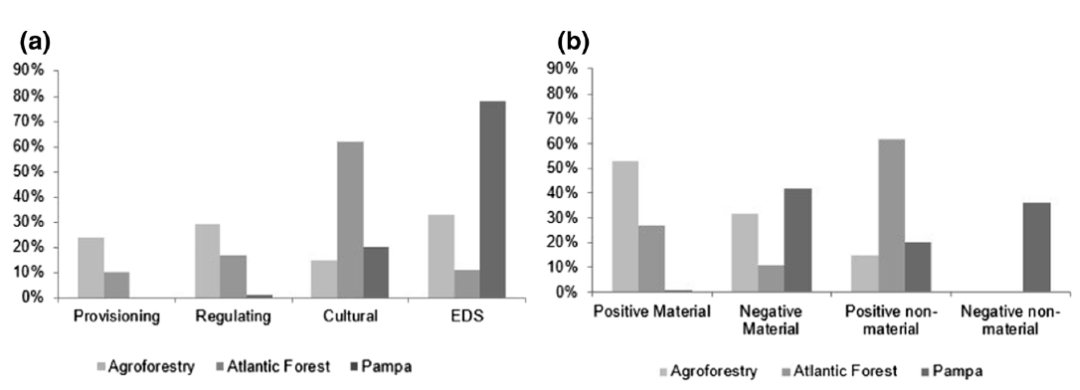
Proportion of interviewees’ responses for each type of: a ecosystem services (including provisioning, regulating, and cultural ES), and ecosystem disservices; and b contributions: positive material, negative material, positive non-material, and negative non-material
受访者对于每种类型的回答比例:a 生态系统服务(包括供给服务、调节服务和文化服务)和生态系统负服务;b 贡献:正向物质、负向物质,正向非物质和负向非物质
中文摘要
背景:景观研究途径和生态系统服务框架已经被广泛应用于探讨人类与自然的关系,以及实践于景观规划与管理。但是,生态系统负服务以及它们如何影响人类与生态系统的交互作用却很少受到关注。
目标:我们旨在通过三个对照案例研究,评估人们对森林生态系统服务和负服务的偏好与认知。同时,针对性地讨论了在景观偏好和社会文化价值研究中同时考虑生态系统服务和负服务的潜在价值。
方法:我们在农林复合景观(法国),大西洋沿岸森林以及潘帕斯草原(巴西)分别对当地利益相关者进行了访谈。将可识别的生态系统服务和负服务归类为常见的类型,通过描述分析和定量方法评估了受访者对于不同森林类型生态系统服务/负服务认知的差异性。
结果:受访者列举了19项生态系统服务类型和11项生态系统负服务类型,并且各案例研究之间存在很强的变异性。结果显示,受访者之间的感知/认知和偏好是不同的。在农林复合景观中,生态系统负服务尤其被人们重视,并且引起了人们认知上的差异。在大西洋沿岸森林景观中,对森林的不同认知多是源于生态系统文化服务产生的差异。在潘帕斯草原的案例研究中,对于保有大量外来种的林场,人们对生态系统负服务的偏好体现地尤为突出。
结论:本项研究表明不同类型的森林地区会产生特定的生态系统服务/负服务,说明了它们在景观尺度上具有互补性。因此,生态系统服务和负服务的结合作为一种具有前景的研究途径,可以对生态系统服务社会文化进行更具一致性地评估,进而改进管理建议。
Title
Perceived ecosystem services (ES) and ecosystem disservices (EDS) from trees: insights from three case studies in Brazil and France
Abstract
Context The landscape approach and the ecosystem services (ES) framework have been widely used to investigate human-nature relationships and orient landscape planning and management. However, ecosystem disservices (EDS) and their influence on how people interact with ecosystems have received less attention.
Objectives We aimed at assessing people’s preferences and perceptions of forest ES and EDS in three contrasted case studies. In the meantime, it aims at discussing the potential of considering both ES and EDS in landscape preference and sociocultural valuation studies.
Methods Interviews with stakeholders were conducted in an agroforestry landscape (France), in the Atlantic Forest and in the Pampa grasslands (Brazil). Identified ES and EDS were classified into a common typology and analyzed through discourse analysis and quantitative methods to assess the variability in ES/EDS perceptions among respondents and among forest types.
Results Respondents cited 19 ES classes and 11 EDS classes, with strong variability among case studies. Contrasted perceptions and preferences among respondents were revealed. In the agroforestry landscape, EDS were particularly emphasized by people and contributed to the variability in people’s perceptions. In the Atlantic forest landscape, forested areas tended to contrast based on cultural ecosystem services. In the Pampa case study, EDS were particularly salient in people’s preferences concerning exotic forest plantations.
Conclusion This study suggests that different types of forested areas produce specific ES/EDS, suggesting their complementarity at the landscape scale. The combination of ES and EDS therefore offers a promising research avenue for more consistent ES sociocultural valuations and for improving management recommendations.
编者评
森林景观是目前生态系统服务研究中受关注最多的景观类型,同时它也可以为人类社会提供多种物质和非物质的生态效益。虽然森林生态系统服务的分类和量化研究已非常成熟,但其生态系统负服务才逐渐开始被认知和重视。生态系统负服务大致有三种产生机理:直接影响人类福祉、阻碍生态系统服务流以及造成生态系统服务的损失。由于社会文化背景、利用和管理方式、森林类型等的不同,各利益相关者对于生态系统服务和负服务的认知与偏好并不相同。本文选取三个对照案例进行研究,有助于对不同社会生态背景下的生态系统服务和负服务进行补充完善。结合生态系统服务和负服务,研究人们对于景观的认知和偏好,可以更有效的为景观规划和管理提供建议。
目前多数研究往往单独聚焦于生态系统福祉或生态系统负效应中的一种,很少将生态系统服务和负服务相结合。进行景观规划和管理时,政策制定者和管理者不仅要关注生态系统服务的提升,也应注意生态系统负服务的反馈。本文的创新点在于,将生态系统服务和负服务相结合,基于不同的森林类型和尺度来评估多个利益相关者对于生态系统服务和负服务的认知和偏好。虽然访谈和调查问卷方法本身存在局限性,但本文研究结果足以说明不同的森林类型需采取各自适应性的生态系统服务管理策略,不应该一概而论。
原文信息:
Teixeira, F.Z., Bachi, L., Blanco, J., et al. (2019) Perceived ecosystem services (ES) and ecosystem disservices (EDS) from trees: insights from three case studies in Brazil and France. Landscape Ecology, 34, 1583–1600.
原文链接:
https://doi.org/10.1007/s10980-019-00778-y

本期编辑
孙晓
中国农业科学院
sxdreamfree@163.com